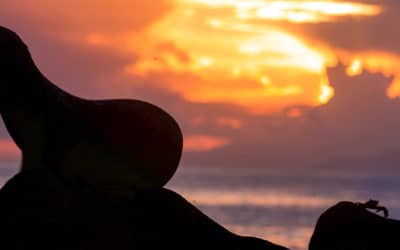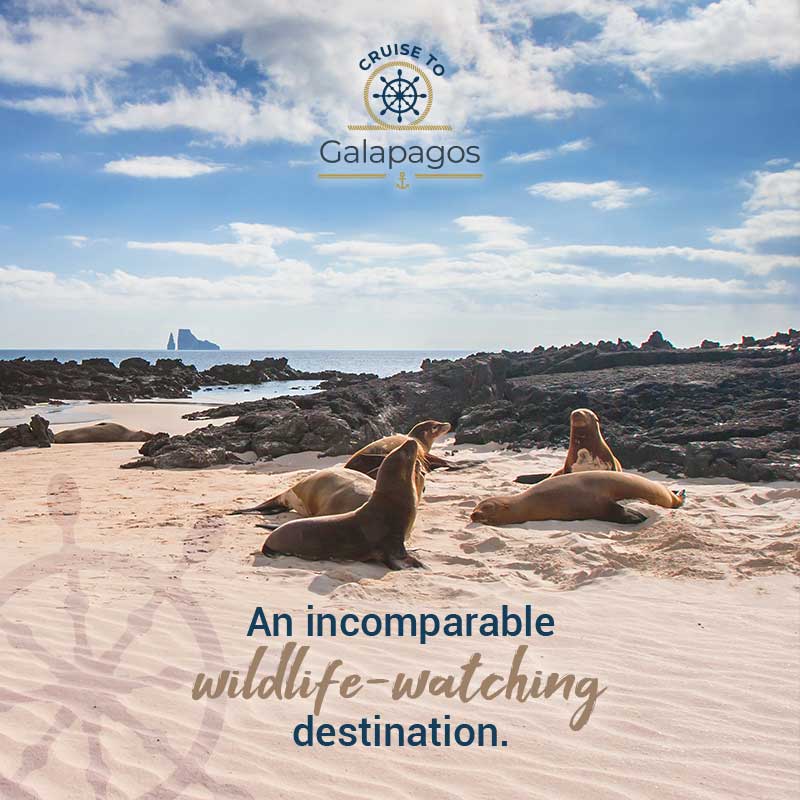Facts about Ecuador
Stay up to date with our most recent news and updates
In this blog we will give you some facts about Ecuador, a country as small as the state of Colorado in the United States, but with an impressive natural, cultural and gastronomic diversity. Its privileged location on the equator gives it unique qualities, such as its pleasant climate and incredible natural regions, which have made it a true paradise within South America.
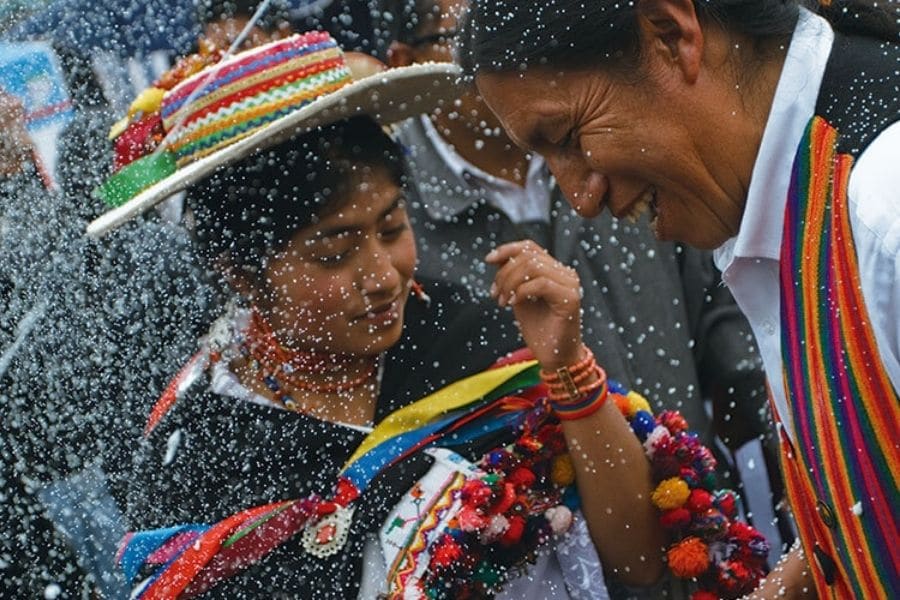
Ecuador, a country full of culture and traditions. Photo taken from: ecuador.travel
Why visit Ecuador?
As we have mentioned before, Ecuador has several spectacular reasons why you should visit it. However, below we have prepared an appetizer of how amazing a vacation there can be.
If you are a nature lover, Ecuador is sure to fascinate you. Not for nothing it is one of the most biodiverse countries in the world, with around 33,000 taxonomic species, that is, almost 6.1% of all the species in the world.
Did you know that orchids are the oldest and most prized flowers in the world, and that in Ecuador you can find around 4,200 known species and 1,300 endemic ones, all of them spread throughout its territory? So if you are a lover of these beautiful flowers, you can admire them on your next vacation there.
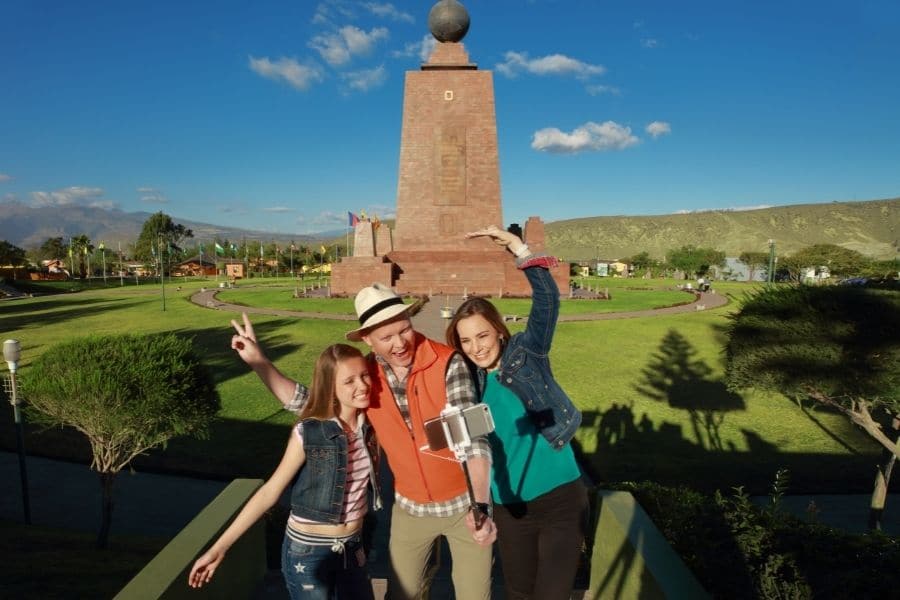
The monument of the middle of the world is one of the most popular sites among visitors who come to Ecuador.
Its privileged location on the equator, which we mentioned at the beginning, makes it a country without equal and possessing 4 incredible natural regions. Yes! We are talking about the mega-diverse Amazon rainforest, the imposing Andean highlands, the rich coast and the amazing Galapagos Islands. With places for everything and for all tastes.
The possibilities that Ecuador offers to adventure lovers are almost endless. If you are one of them, its 4 natural regions will allow you to enjoy an unforgettable kayak through the jungle, as well as to summit one of the snow-capped volcanoes of the Andes. If you are a sea lover, there is no doubt that surfing off the coast or diving with sea lions in Galapagos will give you an otherworldly experience.
Ecuadorian cultures.
In Ecuador, there is not only a great natural diversity, but also a wide cultural diversity. With 32 indigenous cultures that preserve their own language, customs and traditions, we can say that it is a multicultural country.
For this reason, this small and beautiful paradise is chosen by travelers interested in learning about the ancient cultures of South America.
Below, we briefly tell you about two of the most representative indigenous cultures that you will probably have the opportunity to get to know on your next visit to Ecuador.
Otavalos:
Surely you have heard of them, and is that the Otavaleños are very famous around the world for their fabulous textiles and handicrafts. In the famous “Plaza de Ponchos” of the city of Otavalo, considered one of the largest indigenous markets in South America, you can buy a great variety of handicrafts.
The Otavaleños have their own language, which is Kichwa, although they also speak Spanish, which they learn in school from a very young age. In addition, they also keep their own traditional clothing, which is unmistakable. Below, we tell you a little more about it.
Otavaleño men wear a white cotton shirt that represents the spiritual cleanliness of the person, white pants, a dark wool poncho and a felt hat. It is important to mention that all men wear their hair in a long braid, which represents their spirit and vitality, and is part of their identity as Otavaleños.
Otavaleño women’s clothing is composed of 10 pieces. One of these garments is the humaguatarina, a folded cloth that women wear over their heads. In addition to the embroidered shirt with different designs and colors and the anaco (long skirt of black or blue in its various shades), they also wear two sashes tied at the waist: a wide one called mama chumbi of red color, and another thin one or wawa chumbi wue has a variety of designs and colors. They also wear colored headbands.
On the other hand, they also maintain several traditional celebrations, such as the Inti Raymi (Sun Festival) at the end of June and beginning of July and the Yamor Festival (Corn Festival) in September.
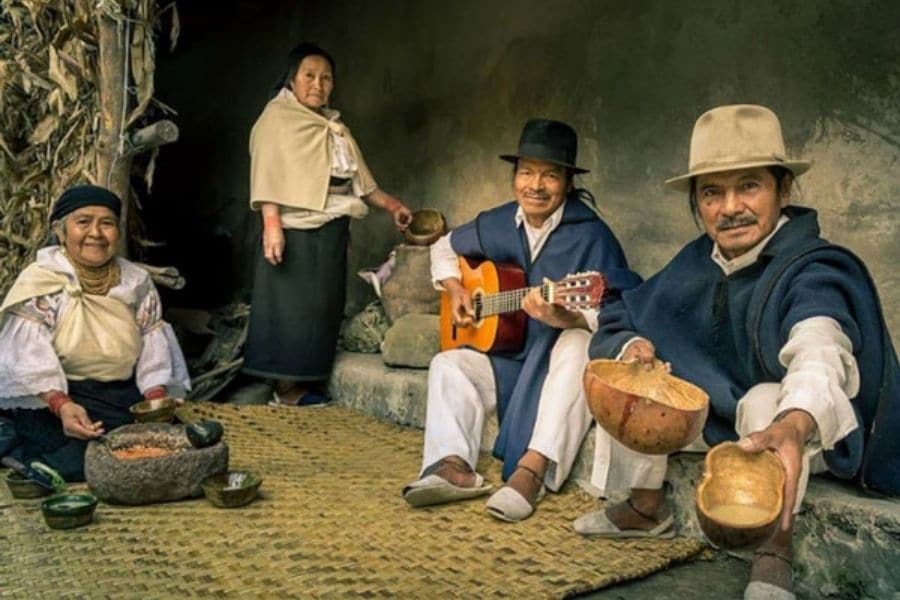
The Otavaleños are one of the most important Ecuadorian cultures in the Andes region. Photo taken from: forosecuador.ec
Waoranis:
One native Ecuadorian culture, which has always lived isolated in the Amazon jungle and was first contacted by a group of American missionaries in the 1950s, is the Waorani.
After the first contact, some of them have yielded in certain aspects to Western culture, such as learning to speak a little Spanish. However, most of them lead a very traditional life based mainly on fishing, hunting, and agriculture. They still live in the provinces of Pastaza, Orellana and Napo.
Although Wao Terero, their language, remains a mystery, most of their population communicates only in this way. The Waorani language has no similarity to any other language on the planet.
Some Waorani communities remain totally isolated from modern society within the Yasuní National Park, away from technology and protecting their ancestral customs and traditions by their own free will.
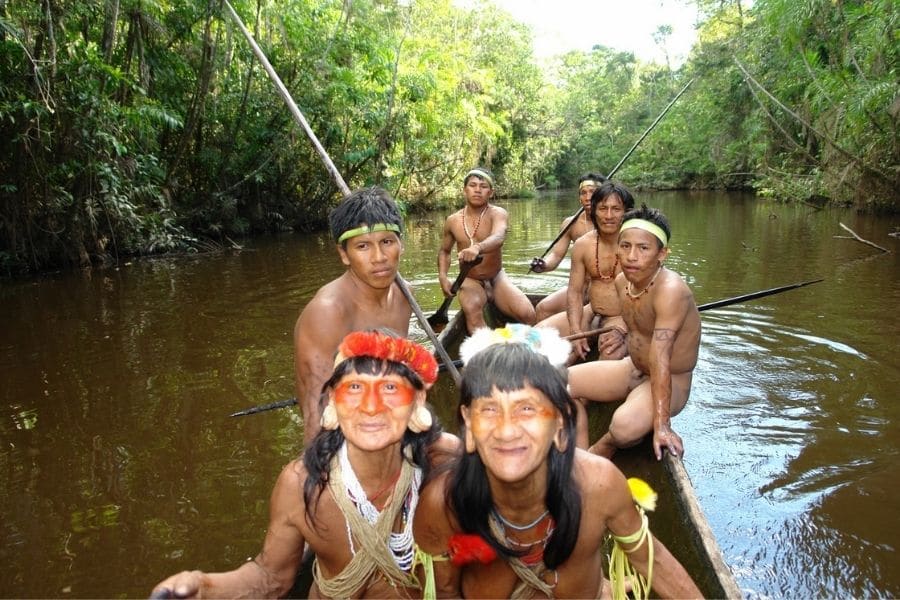
The Waorani native people, Huaorani or just Wao, is one of the few cultures that still preserve several of their customs, such as hunting and traditional clothing. Photo by Kleverenrique on Wikimedia Commons
Ecuadorian traditions:
Numerous ancestral traditions, as well as other interesting celebrations that are a fusion between indigenous and mestizo cultures, which emerged after the Spanish colonization starting in the 15th century, make Ecuador one of the perfect countries to enjoy incredible traditional festivities.
Traditional festivities in Ecuador:
Carnival in Ecuador:
In Ecuador, this traditional celebration is a time of joy and healthy fun activities. It is characterized by the use of water, carnival foam, achiote, eggs and anything that involves dirtying another person, because that is what the “carnival game” is all about.
In addition to “playing carnival”, many families visit the fresh and salt water resorts. Being a national holiday, beaches, pools, rivers, waterfalls, and other similar places are visited by national and international tourists. Therefore, it is recommended to make reservations in advance.
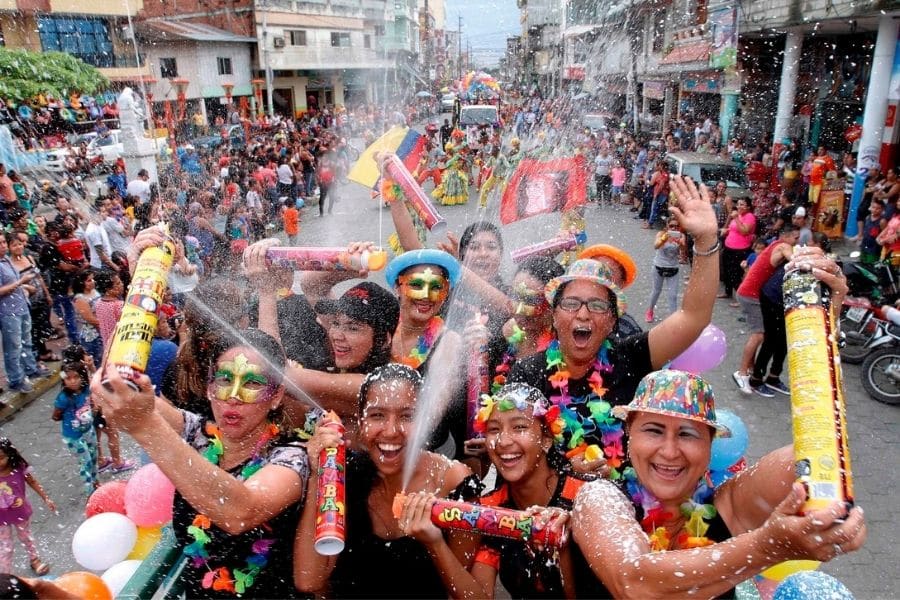
Carnival in Ecuador is one of the most important traditional festivities of the year. Entire families enjoy the events that take place during the carnival. Photo by JONAS on El Universo.
Depending on the city where you want to celebrate the carnival, you will be able to observe different activities. In Quito and Guayaquil, for example, you will see parades of colorful floats, school bands and dance groups dancing to traditional and contemporary music.
On the other hand, in Ambato, the carnival known as the “Festival of Fruits and Flowers”. The colorful floats that are presented in the parades of this city are decorated with bread, flowers, and fruits of the area, becoming authentic works of art. The Ambato carnival could be considered the most important celebration of the year in this city.
After so much joy and festivities, Ecuador’s carnival concludes on the Tuesday before Ash Wednesday, which marks the beginning of Lent in the Catholic religion and the eve of Holy Week, which we will talk about next.
Easter (Holy Week):
During Easter in Ecuador, you can witness and participate in numerous events of the Catholic religion, which generally take place during the first or second week of April. During this week, the locals recreate a spectacular procession of the steps of Jesus towards his crucifixion, in which thousands of believers walk the streets of several cities of the country.
The most important Catholic celebration of Easter in Ecuador takes place on Good Friday in the city of Quito, and is called the “Procession of Jesus del Gran Poder”. It begins in the morning and ends around 15:00, the time when Jesus is believed to have died.

Jesus del Gran Poder procession, in Quito, the capital of Ecuador. Photo taken from: quenoticias.com
During the “Procession of Jesus del Gran Poder”, you will be able to observe the Cucuruchos, a word that literally means “Cone”. These are men and women dressed in purple tunics, wearing pointed cones on their heads. Thousands of cucuruchos walk the path of Jesus, symbolizing the penitents who want to repent and turn away from sin.
The Inti Raymi:
The “Fiesta del Sol”, as the celebration of Inti Raymi is also known, lasts several weeks. It begins with the solstice celebration that takes place on June 21 and lasts until early July.
This traditional Ecuadorian festival is perhaps the largest and most important indigenous celebration in Ecuador. The essence of Inti Raymi, is to thank the god Inti (Sun), for having allowed to obtain good harvests of traditional products.
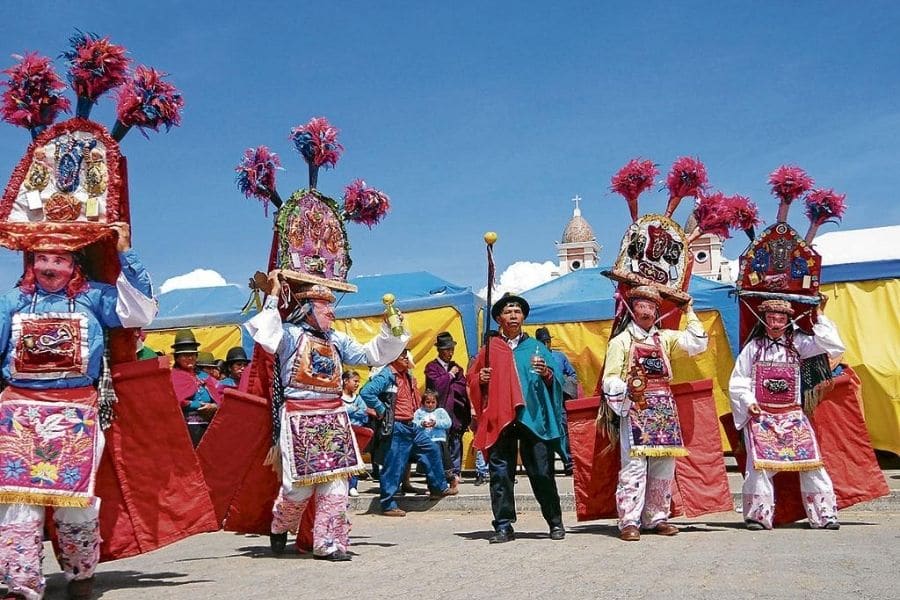
Inti Raymi, one of the most important indigenous celebrations in Ecuador. Photo taken from: El Diario
This celebration consists of various weeks full of dance, traditional music, traditional food and spiritual rituals. It definitely doesn’t sound bad at all, however, if you want to participate in Inti Raymi, we recommend that you join the festivities with an expert tour guide.
Yamor Festival:
This week-long festival takes place the first week of September in the town of Otavalo, located 2 hours north of Quito. Yamor is a traditional drink made from seven different varieties of corn. It usually does not contain alcohol, although those that are fermented for a longer time contain a small amount of alcohol.
The purpose of this traditional Ecuadorian festival is to thank Mother Earth for the corn harvest. This festivity includes a grand parade with dancers while traditional Andean music is played.

Parade of dancers in traditional Ecuadorian costumes during the Yamor Festival. Photo taken from: larepublica.com
Other activities include fireworks, bullfighting (the bull is not killed) and a popular event in which swimmers compete by crossing the waters of Lake San Pablo. In addition, the queen of the Yamor festival, who oversees many of the week’s festivities, is crowned.
The Yamor festival excites both foreign and local tourists. If you are in Ecuador in early September, we recommend that you take part in this unique experience.
Mama Negra:
It is a festival that is celebrated twice a year, in September and November. The Mama Negra (Black Mama) is the biggest event of the year in Latacunga and is considered an incredibly beautiful celebration, as the traditions combine Spanish, African and indigenous influences. Many locals and tourists gather to witness this tradition that runs through the streets of Latacunga, a city located 2 hours south of Quito.
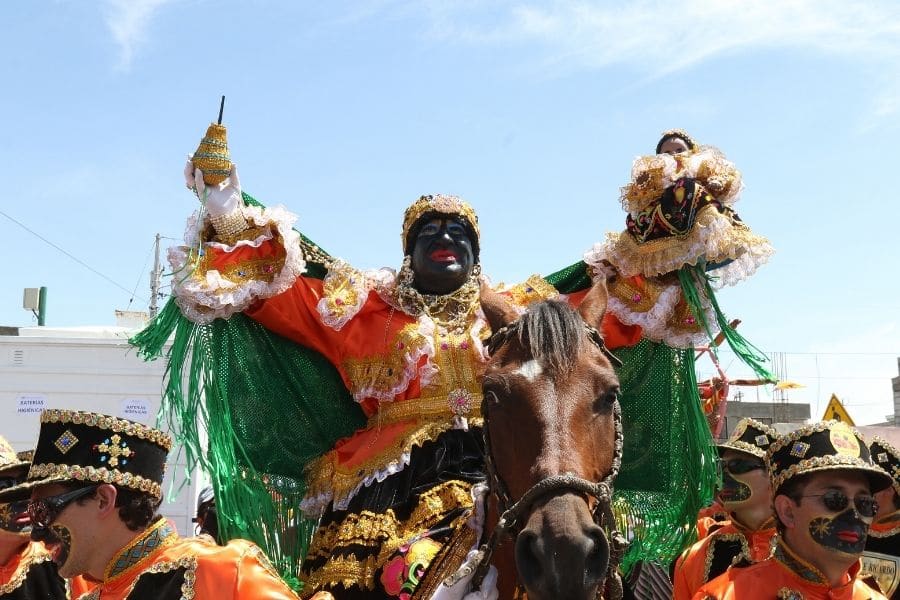
The Mama Negra parade is one of the most important celebrations in Latacunga and Ecuador. Photo by ANDES/Micaela Ayala V. on Wikimedia Commons.
This tradition is a parade made up of outlandish characters, and the highlight is, of course, the Mama Negra. Musicians, dancers, and bands are part of this magnificent theatrical celebration, which ends with the appearance of Mama Negra on horseback. What Mama Negra represents varies depending on who you ask. Some say she is a mixture of the Virgin Mary and African deities, while others say she is a freed slave who became the matriarch of the slaves who were brought to Ecuador.
It is believed that the festival began in 1742 after one of the eruptions of the Cotopaxi volcano. Read more about Ecuador’s traditional festivities, here.
Now that you know some of the most important traditional festivities in Ecuador, we invite you to continue reading our blog Facts about Ecuador, so you can learn more about the highlights of traditional Ecuadorian food.
Traditional Ecuadorian food:
As we mentioned earlier, Ecuador enjoys a privileged location on the equator and a spectacular climate, ideal for growing a wide variety of fruits, legumes, and vegetables in its Andean region, as well as, providing fresh seafood products from its coasts.
Below, we want to tell you more about some delicious traditional Ecuadorian foods that you can’t miss on your next visit to Ecuador.
Encebollado (Fish soup with onions):
This delicious soup is prepared with an exquisite selection of vegetables, and the freshest fish you have ever tasted. Encebollado is considered a true “national symbol” and the most effective solution for “chuchaqui” as hangover is known in Ecuador.
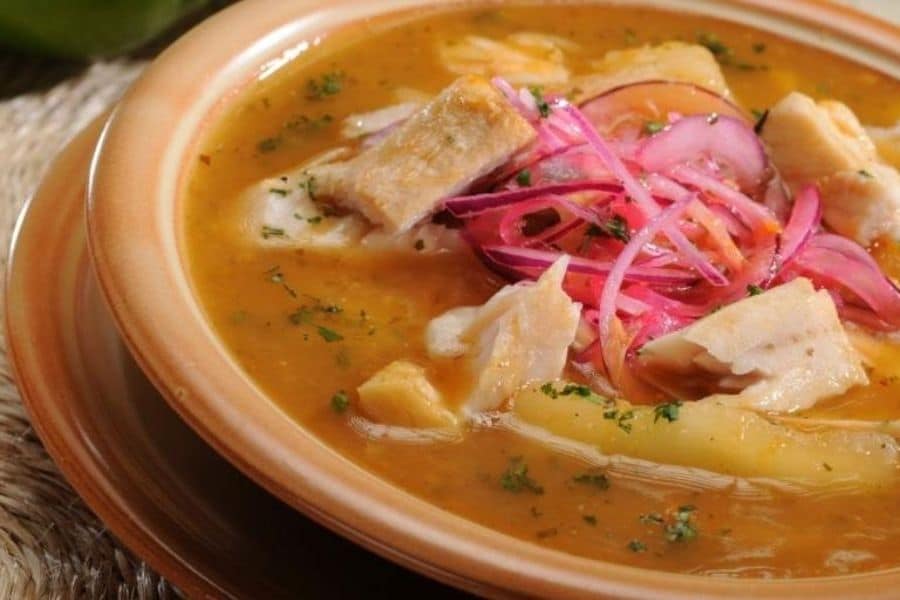
Photo taken from: recetasnestle.com.ec
There is a dilemma between the inhabitants of the highlands and the coast of Ecuador as to how this soup should be served. On the one hand, people from the highlands say it should go with canguil (popcorn), toasted corn and chifles (fried plantain chips), and, on the other hand, people from the coast who say it should go with just chifles and bread. How would you like to try it?
Ceviche:
You are probably thinking that ceviche is not from Ecuador, but rather from a neighboring country. You should know that in Ecuador we have our own way of preparing ceviche.
Very similar to a seafood cocktail, Ecuadorian ceviche can be made with shrimp, fish, shellfish, and a great variety of seafood. This delicious delicacy of Ecuadorian gastronomy is preferred by those who visit the Ecuadorian coasts and are looking for a light and fresh food.
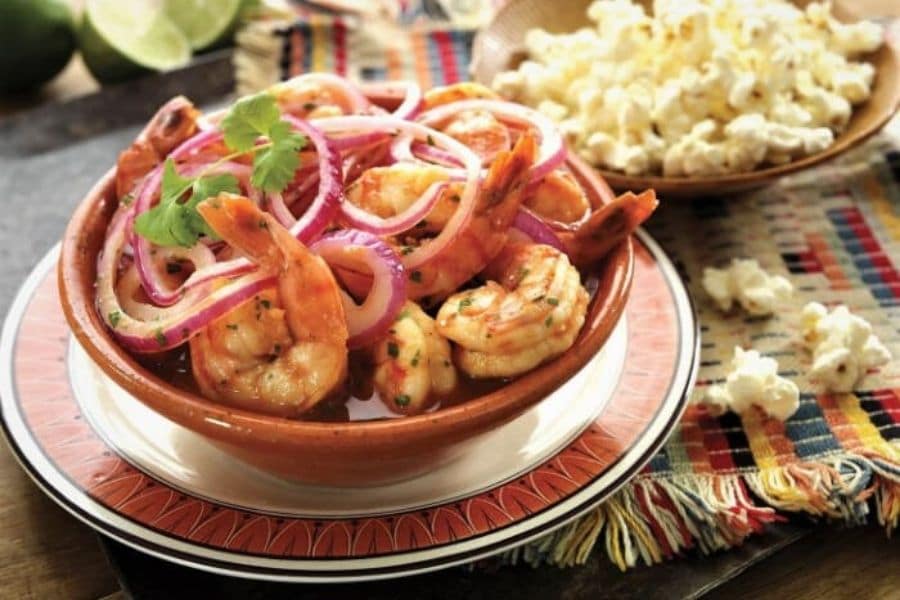
Ecuadorian shrimp ceviche. Photo taken from: camaroneros.info
On the other hand, the Ecuadorian highlands also have their own ceviche, which does not differ much in flavor with the one prepared on the coast, we are talking about the ceviche de chochos. Chocho is a legume that is grown in the Andean highlands and contains a high amount of protein, similar to soybeans. Cevichocho can be a great alternative for those who do not eat seafood and want to try an exquisite Ecuadorian ceviche.
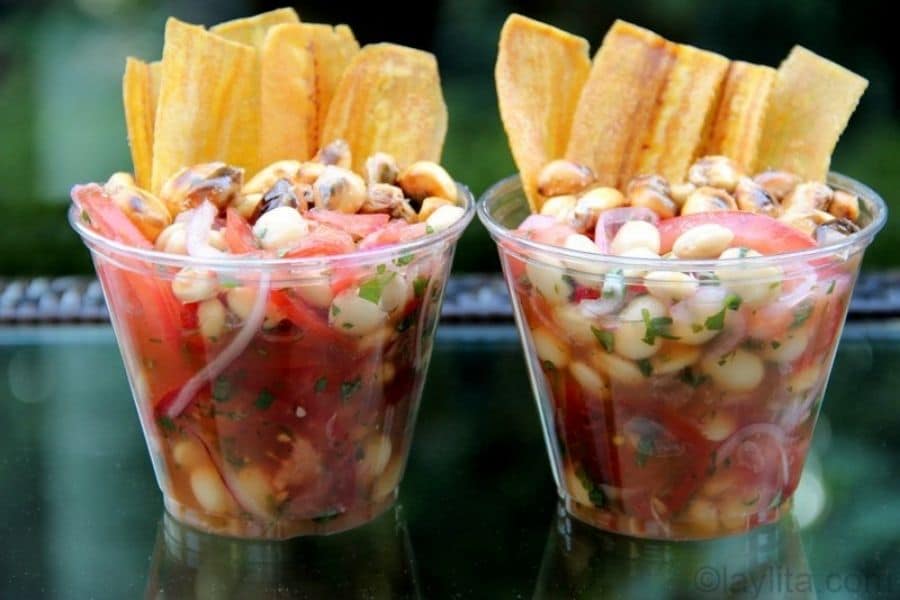
Ecuadorian cevichocho Photo taken from: laylita.com
Pork Fritada:
Fried pork is a traditional dish of Ecuador’s Andean gastronomy, however, it can be found almost everywhere in the country thanks to its great popularity and delicious flavor.

Ecuadorian Pork Fritada Photo taken from: recetasnestle.com.ec
This delicacy of Ecuadorian cuisine, consists of pork cooked in a large bronze frying pan which are then fried in their own fat and can be accompanied by boiled potatoes, cooked corn cobs, or include fried yucca and a fresh salad. Sounds delicious, doesn’t it?
Roasted guinea pig:
Probably, roasted guinea pig, is one of the most exotic dishes of the Ecuadorian Andes. This small rodent has been part of the diet of our ancestors for more than 500 years.
Its high protein level and delicious flavor make it one of the most important delicacies of traditional Ecuadorian cuisine. It can be served with garnishes similar to those of fried pork.
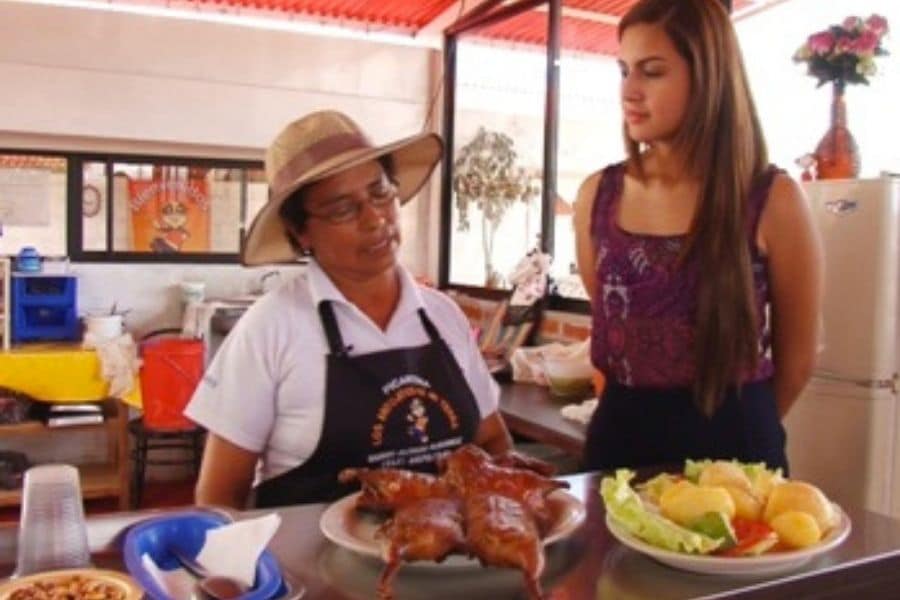
Roasted guinea pig is one of the most exotic and delicious dishes of traditional Ecuadorian cuisine. Photo taken from: mintur.gob.ec
Some say that its flavor is similar to chicken and others that its flavor is unique. Roasted guinea pig is another dish not to be missed on your next visit to the Ecuadorian Andes.
Colada morada with bread guaguas:
This traditional Ecuadorian drink is probably the most common tradition associated with the Day of the Dead, which is celebrated on November 2 throughout the country.
The delicious colada morada is a thick drink that gets its purple color from the mixture of various fruits and purple corn flour, which also has a unique and sweet flavor due to the different spices added to it.
Although its exact preparation varies by family and region, it is the favorite drink of adults and children during the eve of the Day of the Dead. Some drink it hot or warm; others prefer it cold. If that were not enough, colada morada is always or almost always accompanied by a tasty guagua de pan.

Colada morada and guagua de pan, a delicious Ecuadorian tradition to remember the deceased.
“Guagua” is the Kichwa word for baby, so “Guagua de Pan” translates as “bread or dough babies”. The indigenous people of Ecuador traditionally left them at the burial site when someone died to mark the grave and so that the dead person would have food.
In the early 19th century, Catholics adopted this custom, but the ”Guaguas” were not edible. They were made specifically to decorate graves. Today, every bakery in the country sells “Guaguas de pan” in the days leading up to the “Day of the Dead”. They are usually in the shape of a wrapped baby and are decorated with colored icing. Some are filled with fruit jam.
Are you thinking of visiting Ecuador in a month other than November? Don’t worry, in Quito and other cities like Ambato or Cuenca you can find restaurants that offer colada morada all year round, probably without a guagua de pan, but at least you won’t be left wanting to try this delicacy of Ecuadorian gastronomy.
Fanesca (Soup of grains and tubers)
This exquisite soup of traditional Ecuadorian cuisine is a rich mixture of twelve different grains (representing the twelve disciples) and salted fish.
This soup that is only eaten in the weeks leading up to and during Holy Week contains pumpkin, beans, cheese, peas, corn, and peanuts and is garnished with boiled eggs, empanadas, avocado and fried plantains.
Many Ecuadorians enjoy it as a family, since its preparation and consumption is a family social activity. If you visit Ecuador between March and April, you cannot miss the delicious fanesca.
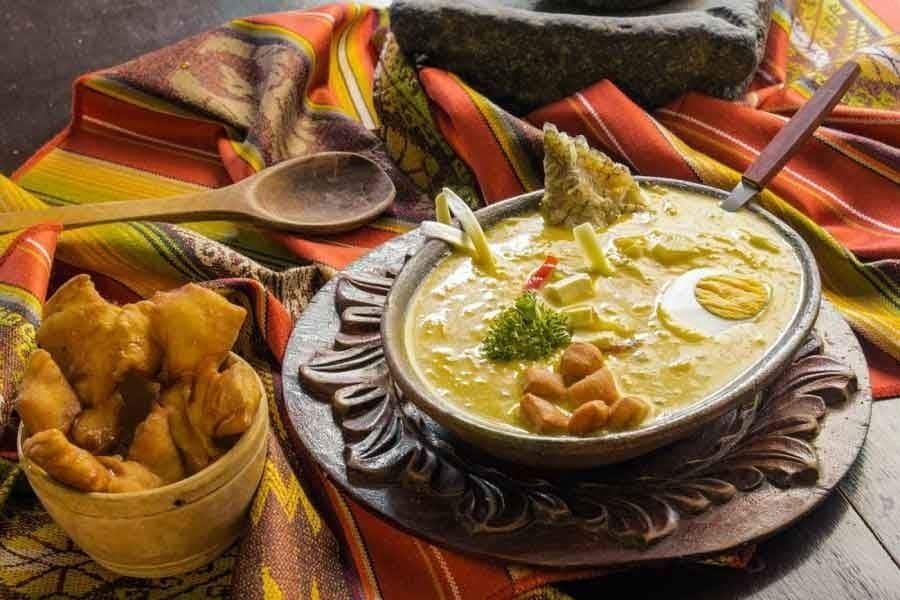
Fanesca, a delicious soup that is prepared in Ecuador during Holy Week. Photo by Tyto08 on Getty Images/iStockphoto
We have already talked about some Ecuadorian cultures, traditional festivals and typical dishes. Now, and before concluding, we want to briefly tell you some interesting facts about the Ecuadorian pasillo, a traditional and unique musical genre.
Pasillo, a Traditional Ecuadorian Music:
The traditional Ecuadorian pasillo is the national musical genre par excellence and was also declared as one of the “Intangible Cultural Heritage” of the country. It is so popular that Ecuadorians of all social strata sing this musical rhythm throughout the country.
It is important to mention that the pasillo has several characteristics acquired in Ecuador that make it unique and special; and that distinguishes it from other varieties of pasillo performed by artists in Colombia or Venezuela. In addition, its peculiar rhythm has made it a fundamental musical genre within the so-called “national music” of Ecuador.
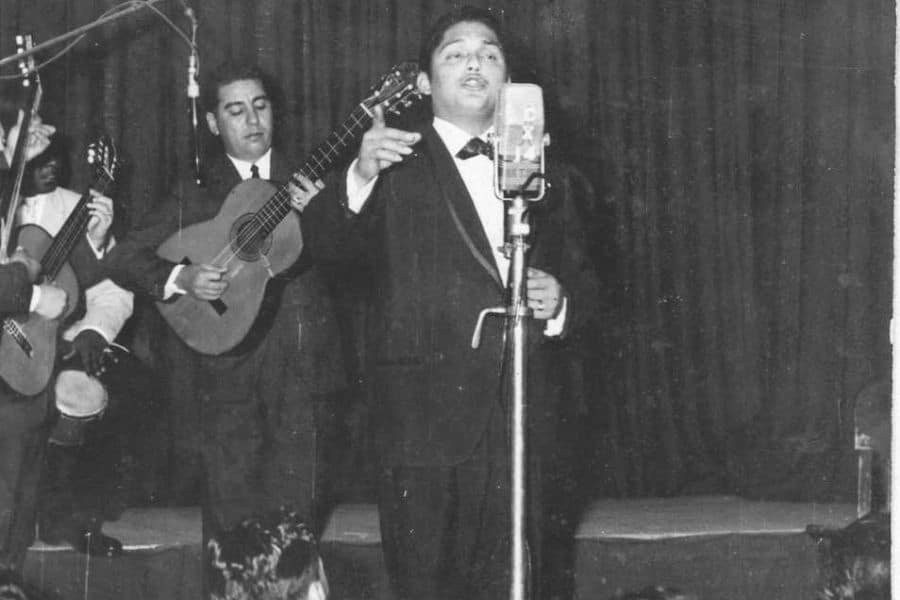
Julio Jaramillo, one of the most important singer-songwriters in Ecuador and Latin America. Photo by Maty1206 on Wikimedia Commons
On the other hand, pasillo is that music with which an Ecuadorian can be identified anywhere in the world because it represents the soul of the Ecuadorian people. Sincerely, the pasillo is a poem made song, it is an unforgettable piece of music, accompanied by a sweet melody interpreted to the sound of the strings of a guitar, a requinto, and sometimes also to the rhythm of violins, accordions, or pianos.
Here is a fragment of one of the most popular pasillos of Ecuador, interpreted by the renowned Ecuadorian singer-songwriter Julio Jaramillo.
After everything that we have been able to tell you through our blog Facts about Ecuador, we hope that you will be encouraged to visit this wonderful country that keeps an incredible cultural beauty.
If you have any questions about Ecuador or the Galapagos Islands, we would appreciate if you write to us at [email protected] / [email protected]. It will be a pleasure to answer your questions and help you plan your next personalized adventure.
RELATED POST
Covid-19 Situation in the Galapagos Islands
Do you want to visit this tourist destination but are you worried about the COVID-19 situation? Enter this blog and discover the good figures
Colada Morada & Guaguas de Pan
The All Souls’ Day or “Día de los difuntos” is an Ecuadorian traditional holiday is celebrate with Colada morada and Guaguas de pan.

